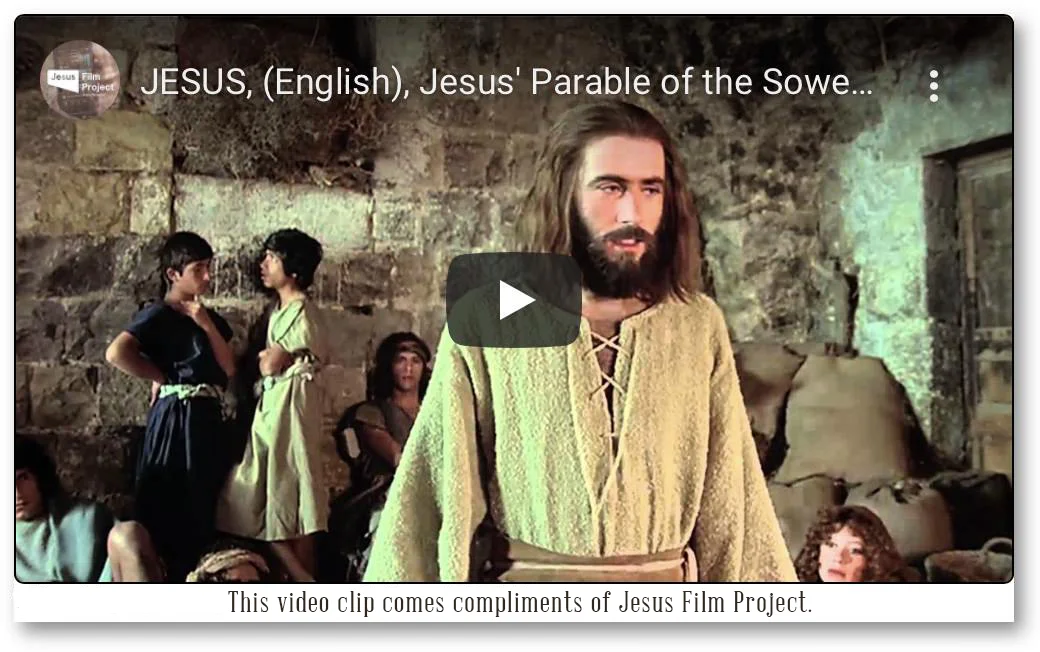The farmer in this parable (God) planted seeds in four different types of soil. Only one of the soil types produced a plentiful crop. So, what's its meaning?
Jesus explained that the four soil types represented the heart of each person onto whom seeds were sown. When the word of God (the seed) is planted in a receptive heart, good things will be produced in that person’s life.
— Preview —
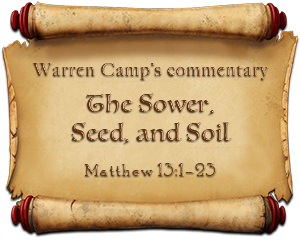
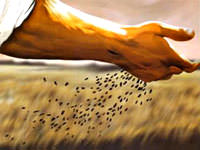
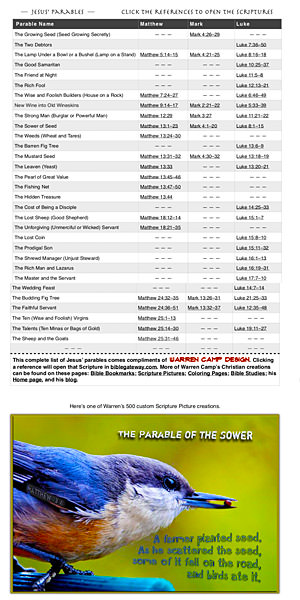
Click the list or the “bird” to enlarge and use Warren’s list of forty-four of Jesus’ parables (a PDF file with links to Scriptures).
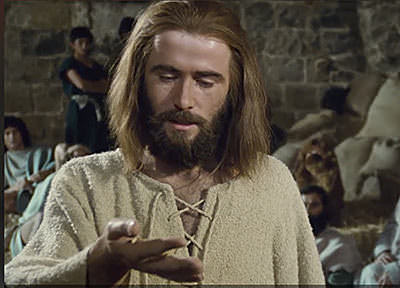
Watch this popular JESUS film clip about the Parable of the Sower, the Seed, and the Soil.

Take our “Parables Quiz.”
See Warren’s other “Parables of Jesus” commentaries.
par•a•ble [noun] a simple story used to illustrate the meaning of or a moral or spiritual lesson, as told by Jesus in the gospels
synonyms: allegory, moral story/tale, fable
The Sower, Seed, and Soil
Matthew 13:1–23
In this parable, Jesus tells us that there are two reasons he uses parables when he teaches: to reveal and conceal. That is, to reveal truth to those who have accepted him and to conceal truth from those who have rejected him.
The principle applies to us today: If you respond positively to what enlightenment and teaching God has given you, then God will give you more enlightenment. But if you reject his teaching, you won’t get any more of it from him. And if you fail to step into his light, which he’s shone before you, no more will be offered. But if you follow his light and obey the truth that you’ve been shown, God will share more truth with you. After all, if you don’t follow and obey, why should God give you more?
In contrast to the Parable of the Weeds (or Tares), the Parable of the Growing Seed, and the Parable of the Mustard Seed, we find this to be a long, multilevel agriculture parable of seed and soil. Jesus also told these three seed- and tree-related parables: Parable of the Workers in the Vineyard, Parable of the Budding Fig Tree, and Parable of the Barren Fig Tree.
What is a parable? Why did Jesus intentionally utilize them? Jesus used parables in his teaching. But with this one it becomes his supreme teaching method. That said, what exactly is a parable?
The Greek for “parable” — parabolḗ — literally means to compare things by throwing or placing things along side each other. The technical definition of a parable is that it’s an extended simile. The comparison is expressed clearly in “the kingdom of heaven is like . . .” which is a story or prolonged comparison, not a simple simile. The Hebrew word for it, masal [mah-shal]), means “to be like.”
Jesus drew from common life experiences of the people to explain a specific principle or teaching about the kingdom of heaven.
Parable of the Sower? The Seed? The Soil?
Parable of the Sower and Seed? The Seed and Soil?
Matthew 13:1–23
[Luke’s account of this parable can be found in Luke 8:1–15.]
Because this parable includes three essential elements, it should be titled appropriately using all three elements: “The Parable of the Sower, the Seed, and the Soil.”
The word “parable” comes from the Greek parabolḗ, meaning “a side-by-side comparison” of two concepts or meanings. Matthew records two rationales for parables, one for outsiders and one for disciples. Jesus explains the parable to his disciples because revelation is given to some and not to others. What’s being revealed to the disciples isn’t (a) the person of Jesus or (b) the nature of God. It’s the coming of God’s kingdom into history, in advance of its glorious manifestation. Sometimes a parable’s second meaning isn’t explained. In such cases, we should be careful about interpreting parables when their meaning isn’t given. In today’s parable, Jesus explains its meaning.
The Israelites understood farming because it was their culture. They could appreciate what Jesus was now telling them, whether they understood the intended analogy or not. They should have gotten it. In effect, Jesus explains that those seeds that God sows represent his teachings about the kingdom of God. The four soil types represent four different ways that Scripture — his Word — can be received in the hearts of different types of people. Undoubtedly, most people who’d listened to Jesus’ parable would have been familiar with the theme of planting seeds. A field would be plowed before seeds would be sown onto a variety of four soil types.
Soil Type I When farmers and workers walked often in the same place, hardened paths were formed, preventing seeds that fell on paths from penetrating the soil and germinating. Seed-eating birds would jump on the opportunity to dine on freshly scattered, fully exposed seed, which they quickly consumed.
As he was scattering the seed, some fell along the path, and the birds came and ate it up (Matt. 13:4).
This hardened soil type represents those people who see and hear God’s Word but don’t understand it or allow it to penetrate their hearts. The message of what God says can’t take root before Satan swoops down as a bird would and snatches it away.
Soil Type II Apparently, Palestine had soil that farmers relished as being “fertile.” However, in many areas, such rich soil often wasn’t very deep. As a result, when farmers dug through their topsoil, they quickly hit hardpan and rock. Freshly sown seeds of grain and plants quickly sprouted but soon died because their roots had no opportunity to flourish.
Some fell on rocky places, where it did not have much soil. It sprang up quickly, because the soil was shallow. But when the sun came up, the plants were scorched, and they withered because they had no root (v. 5–6).
This soil type represents people who readily and genuinely accept God’s Word but on a shallow level only, causing it to quickly wilt and expire. For these people, seed falls on their shallow soil covering. They immediately make an emotional decision to embrace God’s Word but their commitment level has no depth or substance capable of permitting spiritual growth.
Soil Type III The third type of soil is one that is already filled with thorns and weeds, thereby compromising full growth. The grain and plants grew but the thorns and weeds robbed the seeds of essential nourishment. The thorns and weeds would challenge the young growth, preventing it from blossoming and bearing fruit.
Other seed fell among thorns, which grew up and choked the plants (v. 7).
This soil type represents a person who becomes a Christian but soon yields to worldly temptations and distractions, such as worry, wealth, and personal gain. The prioritizing of such distractions prevents spiritual nutrition, cultivation, and life. Sadly, soil-type-III people bear no fruit at all.
Soil Type IV But this fertile soil type on which the seeds were sown represents the person who hears the good news about Jesus Christ and fully comprehends its implications, value, and meaning. It’s this type of person who, after hearing the good news about who Jesus Christ is, spiritually produces a good crop that’s blessed with a fruitful abundance of varying yields.
Still other seed fell on good soil, where it produced a crop — a hundred, sixty or thirty times what was sown (v. 8).
Do you represent this fertile, fruit-bearing soil type?
Thirty-fold was a good crop yield in Palestine, but it’s been asserted that a hundred-fold yield has been reaped in the Plain of Esdraelon in recent years. It’s also been shown that all four several conditions can be readily found lying close to each other in the Plain of Gennesaret.
“Whoever has ears, let them hear” (v. 9).
Jesus expressed his “Whoever has ears, let them hear” saying often. His intent was to prevent his listeners from regarding what he told them in his parables as merely an attention-getting story that people might remember. It warned them of a parable’s meaning beneath the surface; it incited them to explore such significance on their own.
One of the most familiar parables in the Bible, this parable probably won’t need much explanation, especially since it’s one that Jesus intentionally clarifies for his disciples. This initial section (vv. 3b–9) is most helpful because it not only explains why parables were being used but gives the meaning of the parable itself.
10The disciples came to him and asked, “Why do you speak to the people in parables?” 11He replied, “Because the knowledge of the secrets of the kingdom of heaven has been given to you, but not to them. 12Whoever has will be given more, and they will have an abundance. Whoever does not have, even what they have will be taken from them. 13This is why I speak to them in parables: Though seeing, they do not see; though hearing, they do not hear or understand (vv. 10–13).
To understand this passage, we must remember that it was the teaching of Jesus that was under discussion at this point. In the beginning of his ministry, he taught plainly; all his hearers had equal opportunity to know his doctrine and believe in him. But subsequently, his teaching would be largely veiled in parables designed to enrich the knowledge and understanding of believers while adding no such comprehension for the multitude of unbelievers; their efforts to understand the parables would withdraw their minds from the truths that they’d already learned, so that they’d either forget them or fail to gain from them. For us today, if we attend to the meaning and purpose of each parable, we’re bound to gain from making such efforts; but if we fail to see their value and relevance in our discipleship, our loss becomes immeasurable.
Jesus makes a “them and you” distinction between the crowds and his disciples. The emphasis is not so much on the disciples’ ability to understand, which they have in part but not completely, but on the fact that revelation has been given to them.
14In them is fulfilled the prophecy of Isaiah: “You will be ever hearing but never understanding; you will be ever seeing but never perceiving. 15For this people’s heart has become calloused; they hardly hear with their ears, and they have closed their eyes. Otherwise they might see with their eyes, hear with their ears, understand with their hearts and turn, and I would heal them.’
16But blessed are your eyes because they see, and your ears because they hear. 17For truly I tell you, many prophets and righteous people longed to see what you see but did not see it, and to hear what you hear but did not hear it (vv. 14–17).
Jesus now lays out parallel concepts to explain his meaning. He doesn’t explain every detail — no explanation is given for the sower, the path, the rocky ground, or the diverse yield. The general point is that the seed is the message of the kingdom.
18“Listen then to what the parable of the sower means: 19When anyone hears the message about the kingdom and does not understand it, the evil one comes and snatches away what was sown in their heart. This is the seed sown along the path. 20The seed falling on rocky ground refers to someone who hears the word and at once receives it with joy. 21But since they have no root, they last only a short time. When trouble or persecution comes because of the word, they quickly fall away. 22The seed falling among the thorns refers to someone who hears the word, but the worries of this life and the deceitfulness of wealth choke the word, making it unfruitful. 23But the seed falling on good soil refers to someone who hears the word and understands it. This is the one who produces a crop, yielding a hundred, sixty or thirty times what was sown” (vv. 18–23).
The seed message receives varied responses from people; some hear the message; some don’t. It will take time to develop, due to difficult times and difficult people. It will take a good deal more of Jesus’ teaching before many really understand the mysteries of the kingdom. But in time, thankfully, the message will produce an abundant harvest for those who heed the Sower’s life-changing message.
In addition to the four types of soil or ground, Jesus’ explanation of the Parable of the Sower, the Seed, and the Soil highlights four different responses to the gospel. The seed is “the word of the kingdom.” The hard ground represents someone who’s hardened by sin, who hears but doesn’t understand the Word; Satan plucks the message away, keeping the heart unresponsive and preventing the Word from making an impression. The stony ground pictures a man who professes delight with the Word, however, his heart isn’t changed and, when trouble arises, his so-called faith quickly disappears. The thorny ground depicts one who seems to receive the Word, but whose heart is full of riches, pleasures, and lusts; things of this world take his time and attention away from the Word, causing him to end up having no time for it. The good ground portrays the one who hears, understands, and receives the Word, and then allows the Word to accomplish its result in his life. The man represented by the “good ground” is the only one of the four who is truly saved, because salvation’s proof is fruit.
A Hearty Way to Apply This Parable Today
This sower, seed, soil passage provides us with an introduction (vv. 1–3a), then the parable itself (3b–9). This is followed by Jesus’ explanation of the reason for using parables (10–17). Finally, he explains the meaning of this first of ±44 parables (18–23). Herein, Matthew’s account is almost entirely the teaching Jesus, except for the parable’s introduction, the question asked by the disciples, and the citation from Isaiah.
Jesus used this parable to explain why some people show the results of a healthy, balanced spiritual life and some don’t. In today’s review of the Parable of the Sower, the Seed, and the Soil, you have the chance to think about your spiritual growth going forward.
- As you read Jesus’ description of the four soil types in this Scripture, which of the four best describes your response when you first heard the gospel message? Hard, rocky, thorny, fertile?
- How about your spiritual life today? Is your soil hard, rock, thorny, or fertile?
- Is there a step(s) you should take to improve the fertility of the soil that represents your spiritual life?
It’s our responsibility to know and understand well this parable’s message so we’ll be able to present it as clearly and meaningful as possible. The rest is not up to us but the Holy Spirit of Jesus. If we present it’s essential message as we should, we must accept the fact that only some will accept it and change their lives in a most meaningful way.
May your faith and life exemplify the “good soil” in this Sower, Seed, and Soil Parable.

